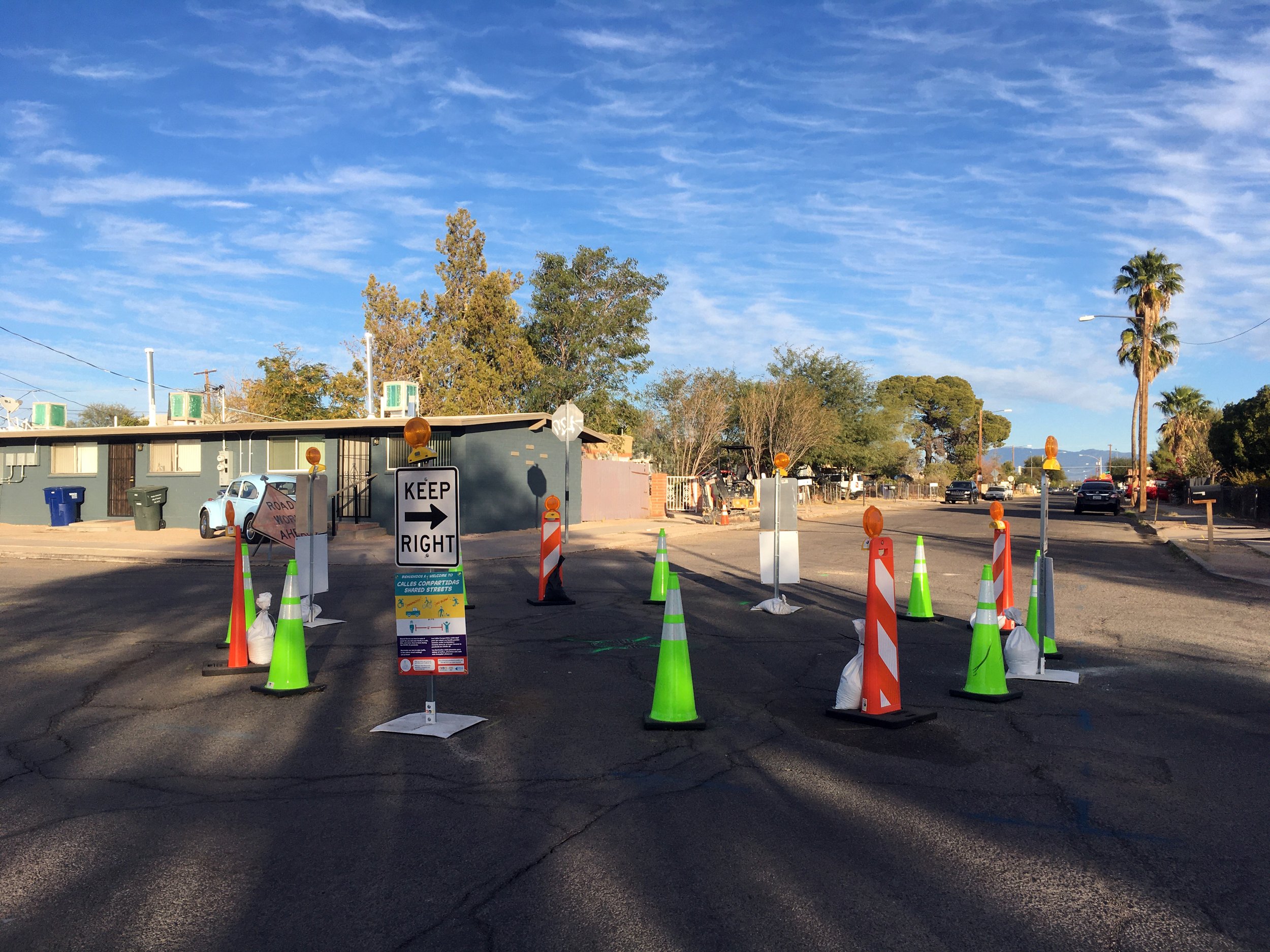Quick Build 101
(Above) Families and neighbors of Ochoa Community School help implement a quick-build traffic circle in 2019.
Part I: A Primer for a Lighter, Quicker, Cheaper Approach to Changing Your Streets
Note: This month we’ll share an overview of what this approach is all about. Next month we’ll go into detail about what some of the treatments can do and how they can take shape.
By now you’ve probably come across the phrase “Lighter, Quicker, Cheaper (LQC)” in news articles and blog posts focused on urban planning. It’s an approach to placemaking coined by Project for Public Spaces. Here at Living Streets Alliance, we sometimes also call it Quick Build or Tactical Urbanism, but essentially they’re all one in the same; a type of project that’s all about making community-visioned changes on the ground happen quickly and in a way that’s inclusive and flexible.
With so much work to be done to create Complete Streets throughout Tucson the LQC approach is a really helpful tool to have in the toolbox. These projects are opportunities for a community to envision what they might want and need without long planning periods or securing big financial commitments. By utilizing the core principles of the the LQC approach—community vision, cost-effectiveness, collaboration, and citizen-led change—cities like Tucson can be responsive to more needs in a shorter period of time, with the added benefit of allowing residents to shape their own neighborhoods.
The biggest different between LQC projects and typical infrastructure projects is that LQC is all about the process—the process of talking with people, generating ideas, trying out those ideas in real space and time, reflecting on what’s working and what could shift, modifying, learning together. LQC projects are more focused on engagement than the end result (though robust and transparent engagement almost always leads to a fantastic end product anyway!).
Temporary materials can be used to experiment with potential chances to traffic flows and patterns. Here (above) cones and signage create the footprint of a traffic circle so neighbors can observe driver behavior before deciding whether or not to make a more permanent traffic circle.
Larger-scale (and by that we mean “hard” / permanent infrastructure like concrete) projects require more time and money to engineer and approve. Because of this community input is often skipped or de-prioritized because it would derail plans and timelines. Since quick-build projects have more flexibility and less budget at stake, it becomes possible to seek input and shift projects based on community input, and at any point in the process. The community is part of the project development and implementation, from weighing in on a design to helping to paint the street. This cultivates ownership and pride of public spaces within a community, which helps ensure that the project will be cared for and utilized well beyond installation.
(Above) Educational signage explaining how a traffic circle works. This LQC traffic circle, located on S. 8th Ave., was installed with the community adjacent to a school where families and faculty wanted to create safer crossing for people on foot. (Below) The finished LQC traffic circle.
Within the streetscape, quick-build can incorporate all kinds of biking and walking safety improvements such as protected bike lanes, pedestrian crossings, curb extensions, traffic circles, and parklets. Quick-build projects are meant to be temporary and show people how a new street feature would impact their neighborhood and the movement of cars, bikes, and pedestrians. No “hard” or permanent infrastructure such as concrete medians or extra lanes are requires, which allows communities to experiment with different treatments and see what works best for their neighborhood needs. The also means materials are lower cost, such as paint, planters, and flexible lane delineators. Quick-build projects can be used “as a first step towards long-term change for communities that recognize the need for improvement but lack immediate resources.”
You can see some examples of LQC projects here in Tucson including traffic circles on S. 8th Avenue, a temporary flex-zone at La Cocina, and numerous streateries currently installed adjacent to downtown restaurants.
Quick build on the horizon
This fall, Living Streets Alliance will be partnering with Barrio Blue Moon and Miracle Manor neighborhoods as well as the Old Pascua community to implement four quick-build projects in collaboration with the Thrive in the 05 initiative. All of the projects will include public murals designed by local artists. They’ll also help slow down cars and calm traffic by narrowing lanes and creating visual cues. And the best part: Each project will be implemented during a community block-painting party, during which neighbors will help bring the art to life!
The upcoming 6th Avenue Asphalt Art Project is also an example of a larger scale quick-build project coming to Tucson. A street mural and planters will be installed on 6th Avenue between 12th and 13th streets with community volunteers to make this active area of downtown safer for people traveling through the area or visiting public green space at Children’s Museum Tucson or Armory Park. You are encouraged to join us on October 22nd to transform the space. Click below to sign up to volunteer from 9 AM-3 PM as part of United Way Days of Caring, or contact us to sign up for a longer or afternoon shift.





